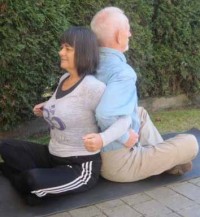By Dorothy Fizzell, SOYA, IYTA, ERYT500, Early Childhood Educator
Bullying among children and teens is a serious issue. In the past, we used to say, “Oh, that’s just kids being kids”, or “It’s just part of growing up”, or “I was bullied and I’m just fine”.
There is growing recognition that bullying is not a “rite of passage” that children must endure because they are different in some way. The key to creating a bully-free environment is to make the environment a safe place for everyone.
What is bullying? According to Olweus, 1991, an expert in bullying research, “a person is being bullied or victimized when he or she is exposed repeatedly and over time to negative actions on the part of one or more persons.” There are different types of bullying, with cyberbullying being the newest type using technology. It has been shown that the reasons children are bullied are the same reasons that people are biased, racist, and intolerant of diversity.
A study on bullying by the University of British Columbia based on 490 students, 50% male, 50% female in grades 8-10 in a BC city in the winter of 1999 showed:
64% had been bullied at school;
13% bullied other students regularly, once or more a week;
72% observed bullying at school at least once in a while.
Source: Centre for Youth Social Development UBC Faculty of Education
There are three ‘players’ in the bullying cycle – the bully, the victim and the bystanders. It is the bystanders who have the most power to stop bullying, and if they know what is fair and unfair, and can take some action, bullying will often stop. Bullies tend to lack empathy, like to have power over the victim, and attention from the bystanders. Victims tend to lack self-esteem and are often not able to stand up for themselves.
An expert in anti-diversity education, Louise Derman-Sparks has developed four anti-bias goals for creating a safe, bully-free environment for all children. These goals correlate with each of these ‘players’ in the bullying cycle.
Using Yoga to Help Prevent Bullying with the four Anti-Bias Goals
1. To enable children to develop a strong sense of self, which helps them feel good, but not superior, about self-identity. (victim)
Yoga Technique: Breathing -This is My Life
Repeat loudly with the movement and breath, “This Is My Life! Mine To Enjoy! And I Feel Great!!”

This (inhale arms in front) Is (inhale a bit more) 
 My (inhale arms up) Life (exhale and fold)
My (inhale arms up) Life (exhale and fold)

 2. To enable children to feel comfortable with one another and with differences, which helps them develop empathy with others. (bully)
2. To enable children to feel comfortable with one another and with differences, which helps them develop empathy with others. (bully)
Yoga Technique: Partner Twist -Feeling another’s heart/breath
Sit back to back, cross-legged, reach around with right hand to touch partner’s thigh, left hand on own right knee, lift & twist, breathe.
 3. To enable children to think critically and seriously about how they and others feel when encountering inequities, which helps them differentiate between fair and unfair treatment. (bystanders)
3. To enable children to think critically and seriously about how they and others feel when encountering inequities, which helps them differentiate between fair and unfair treatment. (bystanders)
Yoga Technique: Balance -Tree
Root left foot into ground, keep left hip long, turn right knee to side and place foot on ankle, calf or thigh; raise hands above head and focus on balance.
4. To enable children to stand up for themselves and for others when facing unfairness and bias, which helps them take action. (bystanders)
Yoga Technique: Grounding -Mountain & Sun Breath
Feet evenly placed under hips, toes forward, lift up through legs, back long, lift ribs, shoulders back, chin parallel to floor; hands up and inhale arms above head, turn hands, exhale hands down.

 Introducing yoga to children can help increase confidence and self-esteem ( the victim); it can assist with developing empathy and compassion for others (the bully), and it can allow children the time, focus and permission to develop problem-solving skills and to feel sure enough in making decisions to take action against biased behaviour (the bystanders).
Introducing yoga to children can help increase confidence and self-esteem ( the victim); it can assist with developing empathy and compassion for others (the bully), and it can allow children the time, focus and permission to develop problem-solving skills and to feel sure enough in making decisions to take action against biased behaviour (the bystanders).
These four yoga techniques can help with each of the four anti-bias goals, allowing environments to be safe for all children, so differences can be celebrated. Yoga teachers can be creative in using other yoga asana and breathing techniques to fit into these anti-bias goals.
Creating a safe, positive environment for everyone decreases the opportunities for bullying to take place, and yoga is one tool to use to accomplish this.
Dorothy Fizzell is a lead trainer for the SOYA 200hr yoga teacher training in the Vancouver area.
Celebrating 30 Years of yoga teacher training excellence in 2025

Recent Comments